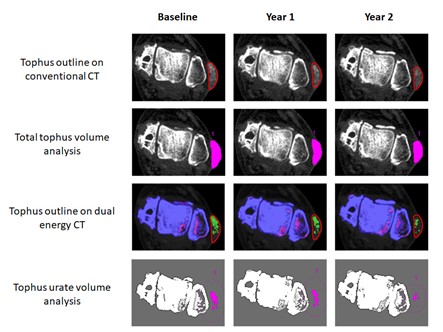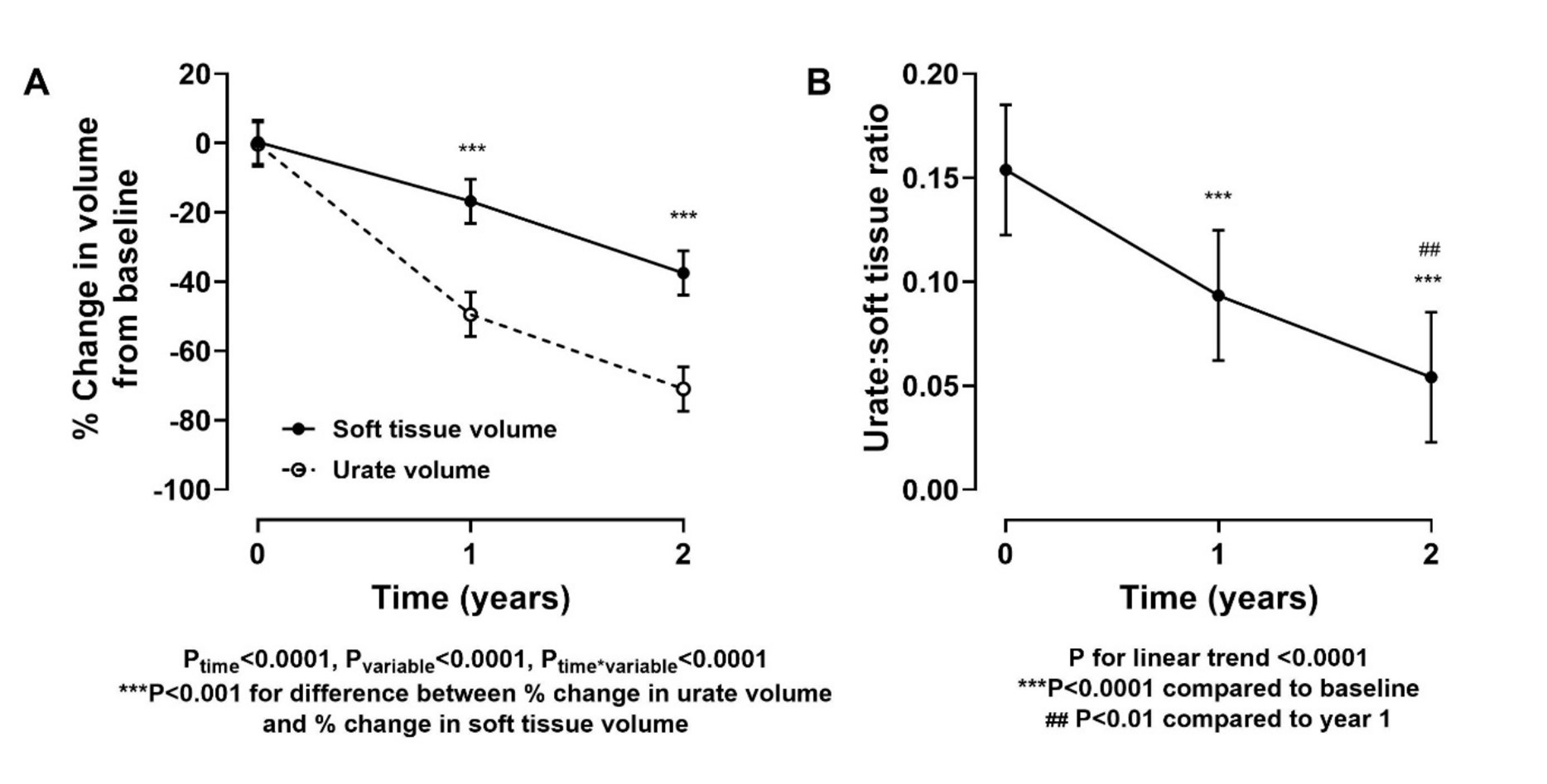Back
Poster Session C
Imaging
Session: (1228–1266) Imaging of Rheumatic Diseases Poster
2203: Changes in Tophus Composition During Urate-Lowering Therapy: A Dual Energy CT Study
Sunday, November 13, 2022
1:00 PM – 3:00 PM Eastern Time
Location: Virtual Poster Hall
.png)
Nicola Dalbeth, MD
University of Auckland
Auckland, New Zealand
Abstract Poster Presenter(s)
Leanne Chen1, Gregory Gamble1, Anne Horne1, Jill Drake2, Anthony Doyle1, Till Uhlig3, Lisa Stamp2 and Nicola Dalbeth1, 1University of Auckland, Auckland, New Zealand, 2University of Otago, Christchurch, New Zealand, 3Diakonhjemmet Hospital, Oslo, Norway
Background/Purpose: The gouty tophus is an organized structure composed of monosodium urate (MSU) crystals and chronic inflammatory soft tissue. Long-term urate-lowering therapy leads to gradual reduction in the size of tophi. However, it is unknown whether the composition of the tophus changes during urate-lowering therapy. Conventional computed tomography (CT) allows measurement of tophus volume in a reliable and reproducible manner. In addition to conventional CT properties, dual energy computed tomography (DECT) allows measurement of MSU crystals within tophi. The aim of this DECT study was to determine whether the composition of the tophus changes over time during urate-lowering therapy.
Methods: Serial DECT scans from 32 people with gout were obtained during a two-year study of allopurinol dosing. All participants received allopurinol dose-escalation, achieved the target SU during the study (< 6 mg/dL) and had evidence of DECT urate deposition within tophi at baseline. DECT scans of the feet and ankles were obtained at baseline, Year 1 and Year 2. Up to five index tophi were selected from each patient, with 103 separate tophi included in the analysis. Using manual outlining methods of conventional CT (CT) and DECT scans, the same index tophi were serially measured for total tophus volume and urate volume. For each tophus, the soft tissue volume was then calculated by subtracting the urate volume from the total tophus volume. Data were analyzed using general estimating equations (GEE) mixed models with analysis of covariance (ANCOVA).
Results: In response to allopurinol dose escalation, the mean (SD) serum urate reduced from 7.2 (0.5) mg/dL at baseline to 5.2 (0.3) mg/dL at Year 2. Within the analyzed tophi, the total tophus volume reduced over the two-year period; from mean (SD) 5.17 (5.55) cm3 to 2.61 (2.73) cm3, P< 0.001. Both the tophus urate volumes and tophus soft tissue volumes reduced over time (P< 0.001), but greater reductions in tophus urate volumes were observed (Figures 1 and 2). Overall, the tophus urate volume decreased by 70.6 [62.8, 78.4]%, and tophus soft tissue volume decreased by 37.8% [31.4, 44.1]%. The tophus urate:soft tissue ratio reduced from 0.15 [0.12, 0.19] at baseline to 0.05 [0.02, 0.09] at Year 2.
Conclusion: This dual energy CT study demonstrates that the composition of the tophus changes during urate-lowering therapy for gout management. While both urate and soft tissue volumes reduce over time, the chronic inflammatory soft tissue within the tophus is slower to respond than the MSU crystals.
 Figure 1. Example of an individual tophus measurement and change in the tophus composition over time
Figure 1. Example of an individual tophus measurement and change in the tophus composition over time
 Figure 2. Comparison of change in urate and soft tissue volumes within all analyzed tophi. A. Percentage change from baseline in urate volume and soft tissue volume; B. Urate volume: soft tissue volume ratio over time. Data are presented as mean (95% CI).
Figure 2. Comparison of change in urate and soft tissue volumes within all analyzed tophi. A. Percentage change from baseline in urate volume and soft tissue volume; B. Urate volume: soft tissue volume ratio over time. Data are presented as mean (95% CI).
Disclosures: L. Chen, None; G. Gamble, None; A. Horne, None; J. Drake, None; A. Doyle, None; T. Uhlig, None; L. Stamp, None; N. Dalbeth, AstraZeneca, Dyve Biosciences, Horizon, Selecta, JW Pharmaceutical Corporation, PK Med, PTC Therapeutics, Protalix.
Background/Purpose: The gouty tophus is an organized structure composed of monosodium urate (MSU) crystals and chronic inflammatory soft tissue. Long-term urate-lowering therapy leads to gradual reduction in the size of tophi. However, it is unknown whether the composition of the tophus changes during urate-lowering therapy. Conventional computed tomography (CT) allows measurement of tophus volume in a reliable and reproducible manner. In addition to conventional CT properties, dual energy computed tomography (DECT) allows measurement of MSU crystals within tophi. The aim of this DECT study was to determine whether the composition of the tophus changes over time during urate-lowering therapy.
Methods: Serial DECT scans from 32 people with gout were obtained during a two-year study of allopurinol dosing. All participants received allopurinol dose-escalation, achieved the target SU during the study (< 6 mg/dL) and had evidence of DECT urate deposition within tophi at baseline. DECT scans of the feet and ankles were obtained at baseline, Year 1 and Year 2. Up to five index tophi were selected from each patient, with 103 separate tophi included in the analysis. Using manual outlining methods of conventional CT (CT) and DECT scans, the same index tophi were serially measured for total tophus volume and urate volume. For each tophus, the soft tissue volume was then calculated by subtracting the urate volume from the total tophus volume. Data were analyzed using general estimating equations (GEE) mixed models with analysis of covariance (ANCOVA).
Results: In response to allopurinol dose escalation, the mean (SD) serum urate reduced from 7.2 (0.5) mg/dL at baseline to 5.2 (0.3) mg/dL at Year 2. Within the analyzed tophi, the total tophus volume reduced over the two-year period; from mean (SD) 5.17 (5.55) cm3 to 2.61 (2.73) cm3, P< 0.001. Both the tophus urate volumes and tophus soft tissue volumes reduced over time (P< 0.001), but greater reductions in tophus urate volumes were observed (Figures 1 and 2). Overall, the tophus urate volume decreased by 70.6 [62.8, 78.4]%, and tophus soft tissue volume decreased by 37.8% [31.4, 44.1]%. The tophus urate:soft tissue ratio reduced from 0.15 [0.12, 0.19] at baseline to 0.05 [0.02, 0.09] at Year 2.
Conclusion: This dual energy CT study demonstrates that the composition of the tophus changes during urate-lowering therapy for gout management. While both urate and soft tissue volumes reduce over time, the chronic inflammatory soft tissue within the tophus is slower to respond than the MSU crystals.
 Figure 1. Example of an individual tophus measurement and change in the tophus composition over time
Figure 1. Example of an individual tophus measurement and change in the tophus composition over time Figure 2. Comparison of change in urate and soft tissue volumes within all analyzed tophi. A. Percentage change from baseline in urate volume and soft tissue volume; B. Urate volume: soft tissue volume ratio over time. Data are presented as mean (95% CI).
Figure 2. Comparison of change in urate and soft tissue volumes within all analyzed tophi. A. Percentage change from baseline in urate volume and soft tissue volume; B. Urate volume: soft tissue volume ratio over time. Data are presented as mean (95% CI).Disclosures: L. Chen, None; G. Gamble, None; A. Horne, None; J. Drake, None; A. Doyle, None; T. Uhlig, None; L. Stamp, None; N. Dalbeth, AstraZeneca, Dyve Biosciences, Horizon, Selecta, JW Pharmaceutical Corporation, PK Med, PTC Therapeutics, Protalix.

